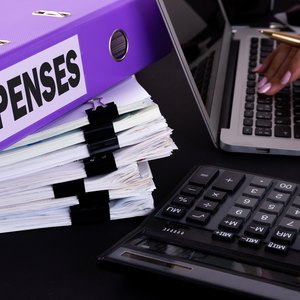
Business expenses must pass the IRS test of being "ordinary and necessary" to be tax deductible. This means that they're commonly accepted in your field of business, and that what you're spending money on is helpful and appropriate to the trade in which your business operates. The IRS says that an expense doesn't have to be indispensable to be “necessary.”
Ordinary and Necessary Definition
Business-related expenses reduce your business’s taxable income so you can reduce your tax burden by claiming as many of them as possible. But it can be tough to know exactly what qualifies under IRS rules.
The top criterion the IRS lists is that the expense must be “ordinary and necessary," and some expenses have additional rules as well. The IRS definition of ordinary is that it must be “common and accepted in your trade or business.” A necessary expense is one that's “helpful and appropriate for your trade or business.” The expense must be both ordinary and necessary to qualify as a deductible business expense.
Ordinary and Necessary Expense Examples
It can help to look at some examples of what the IRS considers to be ordinary and necessary. Here are a few things that you might spend money on that qualify:
- Payroll and retirement plans
- Rent for leased space used solely for your business
- Office space in your home used solely for business activities
- Office supplies
- Equipment
- Marketing expenses, such as printing, postage and online advertising
- Signage for retail locations
- The cost to get products to customers
Read More: Types of Business Expenses
Who Can Claim Business Expenses?
A taxpayer who operates a business to make a profit can claim a deduction for business expenses. You don’t have to incorporate or register your business, but it's important that you be able to differentiate your business from a hobby. A crafter can’t claim the cost of supplies unless those crafts are being sold, but that person might well be considered to be self-employed if they're selling them according to certain qualifying rules.
The IRS doesn't require that you be engaged in your business full time to be considered self-employed. You don’t have to make a profit every year or every month of the year, but your activities must be considered to have a “profit motive,” according to the IRS. You must file Schedule SE and pay self-employment tax if you earn more than $400 a year from your business or self-employment venture.
Operating vs. Capital Expenses
You can also claim another category of business expenses, but not as ordinary and necessary operating expenses. These are known as capital expenses.
The biggest difference between an operating expense and a capital expense is that an operating expense is something that brings benefits to your business on an immediate basis. A capital expense is one that keeps on giving. It will continue to bring rewards down the road.
Capital expenses can include the purchase of business equipment or upgrades that you make to your business space. These investments will hopefully increase the money your business makes on an annual basis well into the future. Startup costs for a new business also fall under the heading of capital expenses. You can choose to take these as one-time deductions or you can amortize them.
Depreciating Business Equipment
The IRS lets you depreciate certain assets that are ordinary and necessary to your enterprise. You can divide their cost over multiple tax years to reduce your tax burden over time rather than claim the expense all in the year of acquisition. The asset must have a useful life of more than a year to qualify for depreciation and it must pass the "ordinary and necessary" requirement to be claimed as a business expense.
First you must determine the useful life of the property to depreciate an asset. The IRS publishes guidelines as to various assets' "useful lives." It's seven years for mainframe computer systems and services, but only five years for vehicles. Divide the cost of the asset over that timeframe. Your deduction for an $8,500 computer would work out to $1,2,14 a year over seven years.
You can use the following methods for depreciation:
- Straight-line depreciation: This method splits the cost evenly over the timeframe.
- Double-declining balance depreciation: You'll take the bulk of the expense in the first year with this method, then decline it in value over subsequent years.
- Modified Accelerated Cost Recovery System depreciation: This method uses the IRS’s MACRS to calculate what you claim each year.
The latter two options can be a complicated process so you might not want to tackle it without the help of a tax professional to make sure you get it right.
Deducting the Cost of Goods Sold
Businesses that sell products deal with an additional type of deduction: the cost of goods sold. In most basic terms, you shouldn't have to pay taxes on $75,000 in sales receipts for products that cost you $25,000 to acquire and maintain until the time of sale.
You can subtract your cost of goods sold from your gross receipts at tax time. This, along with your other deductions and expenses, gives you your business’s gross profits for the tax year. Any expenses you included in the cost of selling these goods can't be taken as a tax deduction elsewhere on your return. You can also deduct costs associated with selling these goods.
The IRS expects you to value your inventory at the start and the end of each tax year.
Deducting Expenses That Are Also Personal
Anything you purchase solely for personal use isn’t deductible for your business, but you might spend money on certain things that you use both personally and professionally. It would still be a necessary and ordinary business expense if you drive your personal car to meetings or to otherwise conduct business, but you also drive your car for personal reasons, but you must calculate your tax deduction.
Start with the percentage of your vehicle's use that's dedicated to your business. Maybe you put 18,000 miles on your vehicle in 2021. You drove 10,000 of those miles for business purposes, which works out to about 55 percent. You're therefore limited to deducting 55 percent of your auto expenses as a business expense. It's imperative that you keep detailed records as to when, where, and why you drove those business miles.
You can choose from two methods for an auto-use deduction: the standard mileage rate or your actual car expenses. The standard mileage rate option is by far the easiest. You can simply deduct a small amount per business mile driven over the course of the tax year: 56 cents per mile in tax year 2021, the tax year for which you'll file a return in 2022. This rate is tagged to keep pace with inflation, so it's actually down 1.5 cents from what it was in 2020, but it increases to 58.5 cents per mile you drive in tax year 2022.
The actual car expenses method requires that you calculate the business portion of your vehicle's operating expenses for the year, including fuel, maintenance, repairs, tolls and lease payments. You can't include the principal part of your car payments if you financed your car because that goes toward repaying your loan and eventual ownership of the vehicle. Your deduction would be $4,950 in the above example where you drove 55 percent of your miles for business purposes and it cost you $9,000 to keep your vehicle on the road all year: 55 percent of $9,000 works out to $4,950.
The Home Office Deduction
You can use either a simplified method or the actual expenses method if you dedicate space in your home to an office or work area. The simplified method claims $5 per square foot of the area of your home that you dedicate to work, up to a limit of 300 square feet.
The actual expenses method works just as it would for your auto. Total what you spent on your home for the year, including mortgage interest or rent, utilities, insurance, real estate taxes and maintenance. Again, the principal part of your mortgage payments isn't included because that contributes to eventual ownership of the asset. Multiply this total by the percentage of space that your work area takes up of your home to arrive at your deduction.
It would be .09 percent of your home-related expenses if your work area takes up 250 square feet of your 2,800 square foot home. Your home office deduction would be $270 a month or $3,240 for the tax year if it costs you $3,000 a month to maintain your residence.
Your home office must meet another set of rules in addition to being ordinary and necessary. You can use the space only for business purposes. You can't deduct the square footage for your entire bedroom simply because you maintain a desk there. You also sleep there. You're limited to the square footage that your desk and work area actually take up.
The area must also be your "principal place of business," and it cannot be the case that you are a remote employee who is required to work from home. You might meet with clients or customers there, or you might run your operation from that desk and nowhere else. You can claim this deduction if you're a dog trainer and you visit your clients' homes to provide services, as long as you operate your business from your home space, scheduling appointments, maintaining your business books, and dealing with advertising and promotion.
How to Claim Business Expenses
Keep receipts for all of your business expenses. You can download an app that lets you easily scan them and store them, which can be helpful if your business keeps you on the road a great deal. Or you do it the good old-fashioned way and keep paper receipts and invoices in folders.
Claim your business expenses on the form that’s appropriate for your business type. Sole proprietors, independent contractors and LLCs use Schedule C, while S Corporations use Form 1120-S. You'll need Form 8829 if you want to claim a deduction for business use of your home. It walks you through the necessary calculations and must be submitted with your return.
Each expense must pass the ordinary and necessary test, as well as the personal vs. business use test. It’s important to be able to demonstrate the business purpose of each expense before claiming it. Touch base with a tax professional if you have doubts.
References
- IRS: Deducting Business Expenses
- IRS: Publication 334 (2020), Tax Guide for Small Business
- IRS: Self-Employment Tax (Social Security and Medicare Taxes)
- IRS: Publication 535 (2020), Business Expenses
- IRS: Publication 587 (2020), Business Use of Your Home
- IRS: Publication 463 (2020), Travel, Gift, and Car Expenses
- IRS.gov: Schedule C
- IRS.gov: Form 1120-S
- IRS.gov: Form 8829
- IRS.gov: Publication 946 (2020), How To Depreciate Property
- IRS.gov: 2021 Instructions for Schedule SE
- IRS.gov: IRS Issues Standard Mileage Rates for 2021
- IRS: IRS Issues Standard Mileage Rates for 2022
- IRS: IRS Reminds Taxpayers of the Home Office Deduction Rules During Small Business Week
- IRS: 1.35.6 Property and Equipment Accounting
Writer Bio
Stephanie Faris has written about finance for entrepreneurs and marketing firms since 2013. She spent nearly a year as a ghostwriter for a credit card processing service and has ghostwritten about finance for numerous marketing firms and entrepreneurs. Her work has appeared on The Motley Fool, MoneyGeek, Ecommerce Insiders, GoBankingRates, and ThriveBy30.
